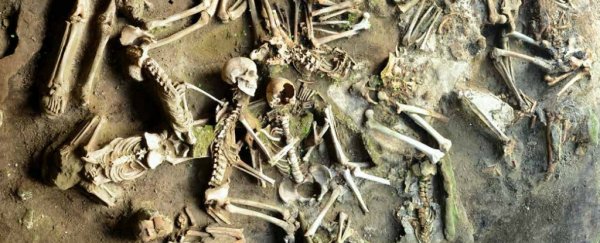The bones of victims of the 79 CE eruption of Vesuvius in the nearby town of Herculaneum have revealed fascinating differences in the diets of the local men and women.
According to an analysis of isotopes in the bones, men ate more cereals and seafood, and women ate more eggs, dairy, and meat from terrestrial animals. The reasons for these gender-based differences are unclear, but could be attributed to differences in occupations, cultural taboos, or power-based societal stratification.
Not only does the work give us this snapshot of life in this ancient Roman town, it describes new analytical techniques that reveal historic dietary data in more detail than ever before.
"The remains of those who perished at Herculaneum in 79 CE offer a unique opportunity to examine the lifestyles across an ancient community who lived and died together. Historical sources often allude to differential access to foodstuffs across Roman society but rarely provide direct or quantitative information," said archaeologist Oliver Craig of the University of York in the UK.
"We found significant differences in the proportions of marine and terrestrial foods consumed between males and females, implying that access to food was differentiated according to gender."
In August of the year 79 CE, you would not have wanted to be in the vicinity of Mount Vesuvius. The rumbling volcano blew its stack in spectacular fashion, killing thousands of residents in the nearby towns of Pompeii, Herculaneum, and other settlements. Most of these victims were either asphyxiated by gas and ash, or killed by the intense heat of pyroclastic surges the volcano sent tearing through its surroundings.
The ash that rained down on these towns was catastrophic; Herculaneum – just 8 kilometers (5 miles) from the volcano - was buried up to 23 meters (75 feet) deep. As a consequence, the bodies of those killed in this event were remarkably well preserved, which has afforded incredible insight into the life of the town.
A team of researchers analyzed bones from 17 people who had died taking shelter from the falling ash – 11 men and 6 women. Specifically, they were looking for isotopes of carbon and nitrogen in the amino acids, which can reveal what a person ate over their lifetime.
This is because combinations of isotopes in the environment can be taken up by plants, to be eaten and absorbed by people and other animals. The mix of isotopes replaces a small portion of the calcium in human teeth and bones, preserving the isotope ratio as a record of their diet.
After finding and analyzing these isotopes, the next step the team used was modelling to reconstruct the diets of the Vesuvius victims. Combined with the high-resolution isotope analysis technique the team used, this allowed for a very detailed breakdown of the people's diets.
On average, they found, the men obtained over 50 percent more seafood protein than women did, as well as a slightly higher proportion of protein from cereal grains than women. Women, on the other hand, ate more terrestrial meats, as well as local fruits and vegetables, and dairy products.
The reasons for this aren't entirely clear. It could have been cultural prohibitions, or an uneven distribution of power, that resulted in certain foods being restricted from women. There was, however, much greater variability among men's diets than among women's; some men ate more cereal grains than others.
This could be preferential, but there could have been other reasons for it. Or, of course, there could have been a number of contributing factors, including the work people did.
"Our research builds on what we know that males had greater access to marine fish at Herculaneum and more broadly in Roman Italy," said archaeologist Silvia Soncin of the University of York.
"Males were more likely to be directly engaged in fishing and maritime activities, they generally occupied more privileged positions in society, and were freed from slavery at an earlier age providing greater access to expensive commodities, such as fresh fish."
The research has been published in Science Advances.
